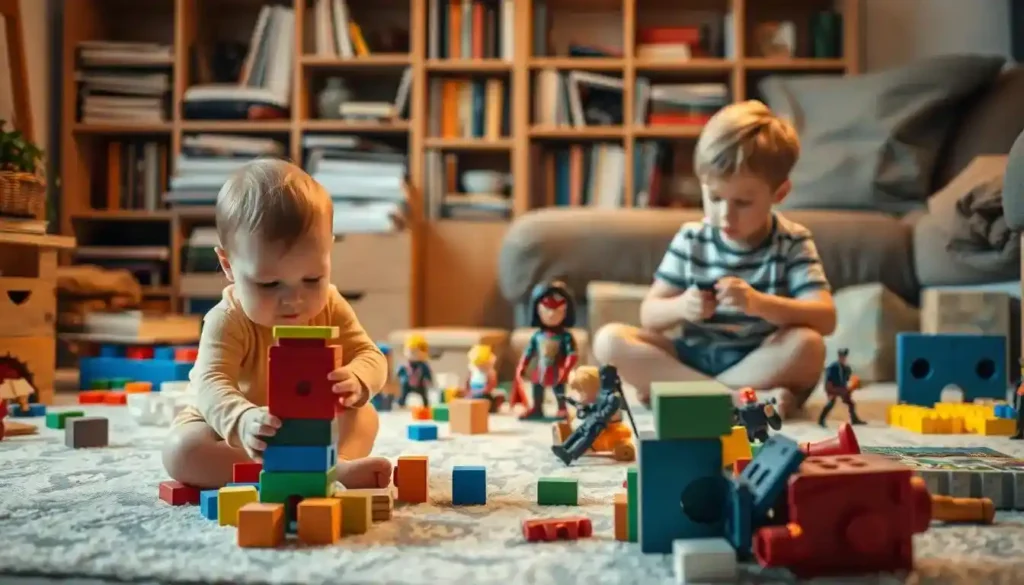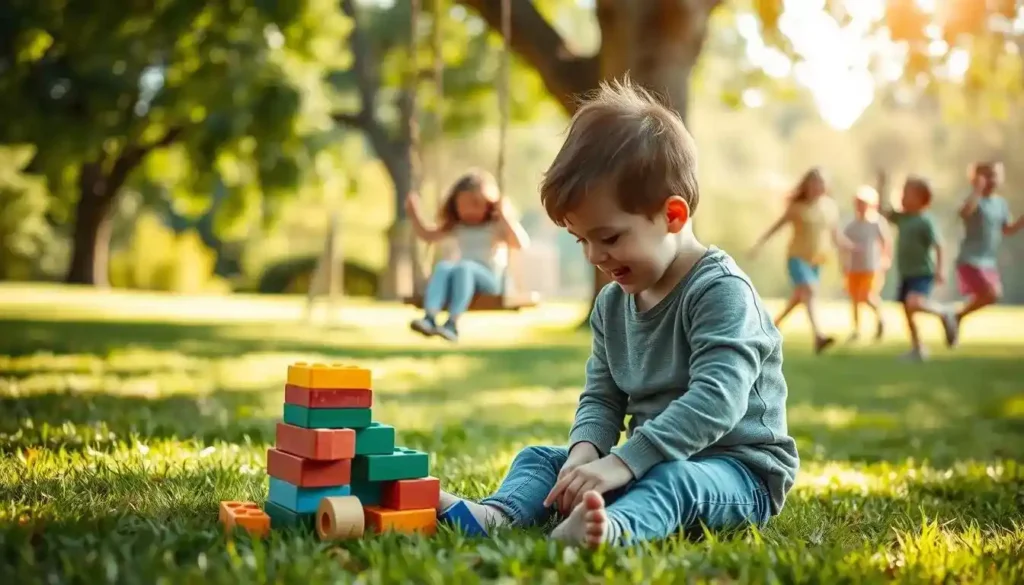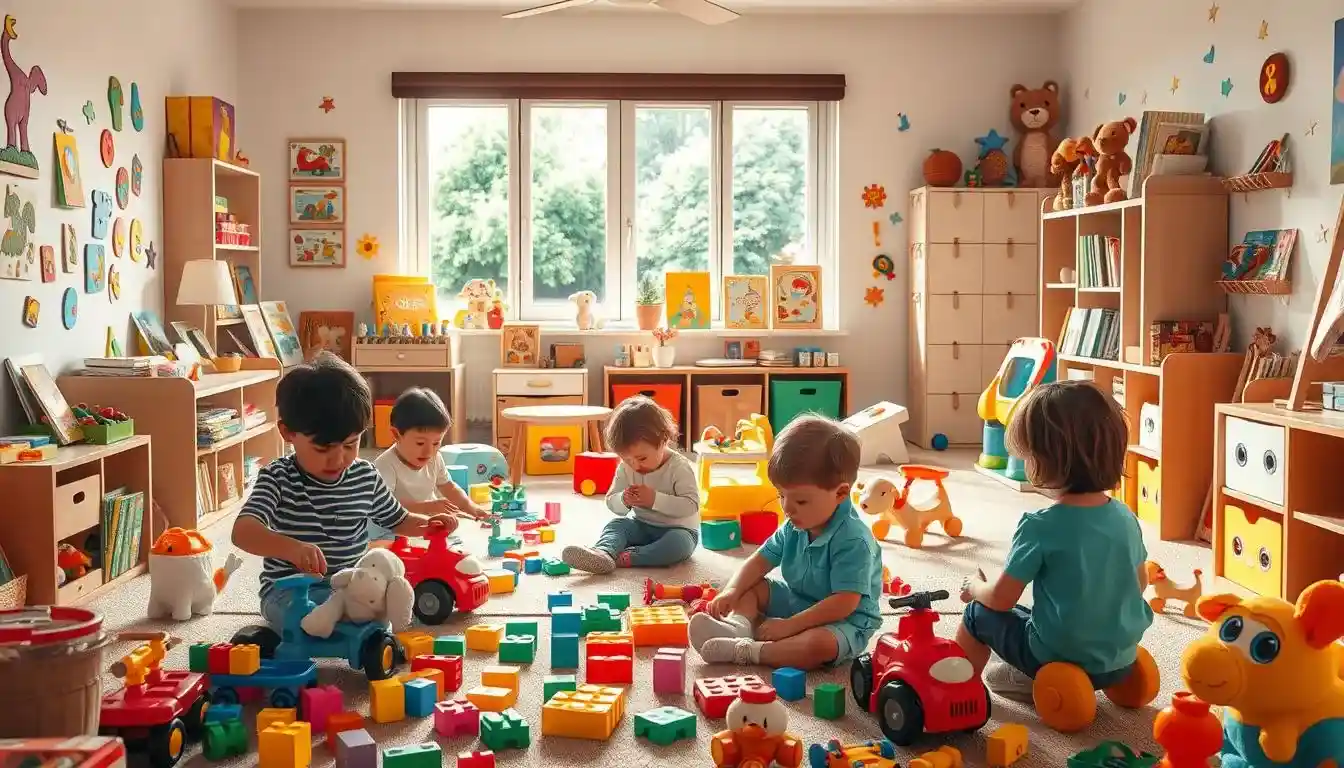When Do Kids Stop Playing With Toys: Understanding the Transition
When do kids stop playing with toys? This question is central to understanding child development and the evolution of play. As children grow, their relationship with toys changes significantly.
As a parent and child development researcher, I’ve seen how kids play with toys change over time. It’s not just about age. Play changes in ways that are personal and influenced by many things.
Play starts with exploring the world and then moves to using imagination. It’s not easy to say when kids stop playing with toys. Some kids start to play less around ages 9-12. Others keep playing creatively well into their teens.
Playing with toys shows how kids think and interact with others. Each stage of childhood brings its own play experiences. These experiences help kids learn about themselves and their world. Knowing these changes can help parents support their kids’ growth.
Key Takeaways
- Play transitions are unique to individual children
- Toy engagement varies across different developmental stages
- Social and cognitive factors influence play behaviors
- Digital technologies impact traditional toy interactions
- Psychological growth determines play preferences
Understanding the Natural Evolution of Play in Child Development
Play is key in child development, helping kids learn and grow. As they get older, their play changes, showing they understand more about the world.
At first, babies learn by touching and looking at things. They start to make important brain connections. This helps them develop skills they’ll need later.
The Role of Play in Early Brain Development
Play becomes a smart way for kids to learn as they get older. Games and activities make their brains work better. They learn to solve problems and think creatively.
Different Types of Play Across Age Groups
As kids grow, their play changes a lot. Toddlers play alongside others, while preschoolers play together more. Each stage helps them learn about relationships and how to work with others.
How Play Patterns Change Over Time
Kids start with simple play and move to more complex games. These changes help them grow in important ways. They learn social, emotional, and thinking skills that help them in school and life.
When Do Kids Stop Playing with Toys: Age-Related Transitions
Every child’s journey regarding when do kids stop playing with toys is unique. There’s no single age when all kids stop playing with toys. However, most kids start to move away from toys between 8 and 12 years old. This transition is significant as their interests expand beyond just playing with toys.
How smart a child gets also affects when they stop playing with toys. Around 9-10 years old, kids begin to favor digital games, socializing with friends, and developing new skills. Instead of traditional toys, they might engage more with board games, video games, or tech-related activities.
Each child is different in how they enjoy toys. Some might continue playing pretend games longer, while others may quickly find new passions. Factors such as personality, friendships, and hobbies greatly influence this change in when kids stop playing with toys.
Digital tech has changed how kids play. Smartphones, tablets, and games offer new ways to have fun. This doesn’t mean kids stop playing. It just means they play in new, more complex ways.
To comprehend when do kids stop playing with toys, we must acknowledge that play evolves rather than ceases. The nature of children’s play may grow more intricate, but their intrinsic need to explore and learn remains constant.

The Impact of Digital Technology on Traditional Toy Play
Digital technology has changed how kids play. Traditional toys now face competition from digital games and apps. Kids are spending more time on screens, changing how they play.
Understanding when do kids stop playing with toys helps parents support their child’s development by recognizing shifts in interests and play styles.
Screen time is a big part of a child’s life. They spend hours on digital devices. This makes it hard for parents and teachers to know what’s good and what’s not.
Balancing Digital and Physical Play
It’s important to mix digital and traditional play. I suggest using apps and smart toys with old-fashioned toys. This way, kids get the best of both worlds.
As children transition from traditional toys, they often seek more complex experiences. This highlights the importance of understanding when do kids stop playing with toys and how to guide them through this change.
Modern Gaming and Virtual Entertainment
Virtual games like Minecraft and Roblox are changing play. They help kids think creatively and solve problems. These games also let kids play with others online.
Knowing about these trends helps parents and teachers. They can make sure kids get to play both online and off. This way, kids can grow up well in our digital world.
Social and Emotional Factors Affecting Toy Engagement
Child development is complex, involving social and emotional factors. These factors greatly affect how kids play with toys. As they grow, their play changes based on their feelings and social experiences.
Peer relationships start to shape toy choices in early school years. What was once loved might seem childish or uncool. Age and play mix in interesting ways, with social acceptance guiding toy choices.
Emotional attachment is key in toy engagement. Some kids keep strong bonds with certain toys, seeing them as comforting or memorable. These bonds can make play last longer than expected, showing play’s personal side.
Social dynamics in friend groups also shape toy preferences. Kids look for toys that help them connect and feel accepted. As they grow, toys become more about showing who they are and getting social approval.
Knowing these social and emotional factors helps parents and teachers support play. It shows that toy engagement is complex. This understanding leads to more meaningful play that respects each child’s emotional journey.
Gender Differences in Toy Play Duration and Preferences
Toy play shows us how gender norms shape childhood. Kids’ toy choices are influenced by cultural messages from a young age. The toy industry has long followed certain gender-based play patterns.
Cultural Influences on Play Patterns
Different cultures shape play in unique ways. In the U.S., boys often play with construction sets and action figures. Girls are usually encouraged to play with dolls and domestic toys. These choices reflect deep societal beliefs about gender roles.
Breaking Traditional Gender-Based Play Stereotypes
Today, we’re moving away from old play patterns. Progressive parents and teachers want kids to try different toys. This helps kids be creative, develop skills, and grow emotionally without gender limits.
Impact of Marketing on Play Choices
Toy makers have a big impact through marketing. Ads often stick to “blue” for boys and “pink” for girls. Knowing this helps parents and teachers choose toys that help kids grow in all ways, not just by gender.
Supporting Healthy Play Development Through Different Stages
Understanding child development means knowing how play changes as kids grow. Parents can help by recognizing key milestones and creating fun, challenging spaces. This supports their child’s interests and growth.
Toddlers learn by touching and feeling things, using toys to make sense of the world. Preschoolers dive into make-believe, creating stories with dolls or action figures. School-age kids enjoy games that need strategy and teamwork.
Supporting strategic play means finding activities that fit a child’s age and abilities. Puzzles, building sets, and craft materials are great. They keep kids engaged and help them think critically and creatively.
Talking to your child about their play helps you understand what they like. By watching their interests, you can pick activities that spark their curiosity. Changing toys and playing together can also help them learn more.
Digital tools can be helpful, but shouldn’t take the place of real play. A mix of screen time and hands-on activities is best. It helps kids grow in many ways, including thinking, social skills, and feelings.

Conclusion
Recognizing when do kids stop playing with toys allows parents to foster environments that encourage exploration and creativity, ensuring that children continue to thrive in their developmental journey.
Investigating when do kids stop playing with toys unveils a complex journey of maturation. Each child’s transition from playing with toys is unique, influenced by their interests, social interactions, and personal growth.
The move from toys to more complex play is a slow change. It shows how a child’s thinking and feelings grow. This change is a big part of growing up.
As kids get older, their play gets more complex. Simple play turns into stories, games, and even more abstract play. Digital tools and friends also change how kids play, opening up new ways to be creative and learn.
Parents and caregivers are key in helping kids grow. Knowing play is vital for kids helps adults support their curiosity and flexibility. Even as play changes, the need for fun, learning, and exploration stays the same.
Every child’s play journey is unique. Accepting this diversity helps us see the beauty of growing up. The most important thing is to support kids’ growth, creativity, and happiness in their play.
FAQ – When Do Kids Stop Playing With Toys?
My 7-year-old stopped playing with toys. Is this normal?
Yes, it’s common for kids to start showing less interest in toys around 7 years old as they explore other activities like games, sports, or digital entertainment. Every child is different, so some may still enjoy toys, while others might prefer new interests.
What age should a girl stop playing with toys?
There’s no exact age, but many girls begin to move away from toys around 8-12 years old. This depends on the child’s interests and social environment. Some may continue to play with toys longer if they enjoy it.
When do kids stop playing pretend?
Pretend play typically decreases between 8-12 years old as kids become more interested in other activities. However, some kids may continue imaginative play into their early teens.
What age do boys stop playing with toys?
Boys, like girls, may stop playing with toys between 8-12 years old. However, interests vary, and some boys may continue to enjoy toys or switch to more complex games and activities.
Do 7-year-olds still play with toys?
Yes, many 7-year-olds still play with toys. However, some may start transitioning to new interests, like video games, sports, or spending more time with friends.
When do kids stop playing with blocks?
Most children stop playing with simple blocks around 7-9 years old, although some may continue to enjoy building and creating with them in more complex ways for a few more years.
What age do kids stop playing with dolls?
Dolls are often set aside between 8-12 years old as kids start to focus on other interests. However, some children might hold onto their dolls for comfort or use them in more creative play.
When do kids stop playing with toys according to Reddit?
On Reddit, many parents say that kids typically stop playing with toys around 9-12 years old. However, it varies based on personality, social influences, and evolving interests.

